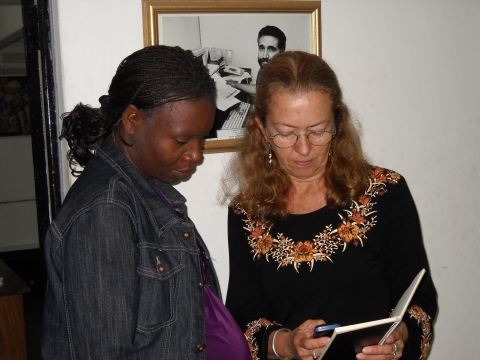
Knight International Health Fellow Mercedes Sayagues (right) works with journalist Salane Muchanga in the Savana newsroom in Mozambique.
Last year, the aluminum production company Mozal quietly requested authorization to operate with direct emissions (or bypass the filtering system) while repairing its Fume Treatment Centers (FTC) for six months, at a cost of $10-million. "Sub-optimal engineering in the centers," was the bland term used by Mozal assets president Mike Fraser to explain the need for repairs. Translation: shoddy quality.
The smelter, one of the largest foreign investments ever in Mozambique, is visible from the highway linking Maputo to South Africa. Mozal provides jobs for 1,000 people, plus 3,000 downstream jobs. It does a lot of charity and is virtually untouchable.
Smelters release some very toxic gases, like sulphur dioxide, fluoride, tar and dust particles. Tar and particulates, especially carbon dust, are potentially carcinogenic.The absence of the FTC’s will now result in extremely fine particles of carbon dust entering the atmosphere. These would under normal operating conditions be filtered by the FTCs.
In July, at a press conference, Mozal officials showed a slideshow but refused to make copies available and assured there would be no harm at all, the toxic gases would be below World Health Organization required levels. But simulations are only as good as the data that is put into the model and Mozal was not explaining which baseline emissions were put into the model, what weather data (prevailing winds are critical) was used and where they got their data from.
Savana reporter Salane Muchanga (who lives in Matola, has a two-year-old and is six-months pregnant, thus very concerned) was following the issue. She wrote a first piece that explained the emissions and toxicity of gases. At the end, she mentioned that the majority shareholder in the project, HBP Billiton, owns the Hillside smelter in Richards Bay, South Africa, 210 kms south of Maputo. She included the fact that an industrial accident in that city had forced an evacuation of downtown in the late 1990s, a bit of information she'd found on the Internet.
Salane and I searched the internet further and discovered the Richards Bay Clean Air Association, set up after the accident in 1997. A non-profit group, it monitors air quality independently, receives and investigates complaints, and shares quality data.
The RBCAA information officer explained that in South Africa, Hillside operates on "bypass" for a maximum 12 hours to do maintenance at the FTC, and only once, exceptionally, for 72 hours, under RBCAA protest. She found it worrying to have direct emissions for six months. She pointed out that in South Africa, impact assessments must be made public and public consultations must be held.
The weekly publication Savana ran her interview and two other stories on Mozal. For the first time since I arrived, a health story made the front page. That day, "Hillside at Richards Bay" became household words.The argument of a double standard - in South Africa this would not be allowed, the process would be more transparent and subject to public scrutiny - gained momentum.
The day Savana hit the streets, Mozal held its first public meting in Matola, a direct result of public pressure. Although scheduled for a Thursday morning, when people are at work, 200 people attended the heated session. Later that day, TIM TV taped a one-hour debate on the bypass, with green activists, residents, Mozal and government authorities. The program was aired twice over the weekend. The arguments and facts presented by Savana figured prominently. Ditto for calls to radio talk shows.
The government-owned media has ignored the issue as much as possible, or parroted the Mozal/government view that no harm will happen. They blasted activists and Savana for being skeptical. Savana and TIM TV have been the most critical. Their coverage, coupled with NGO activism, has had a real impact on the way Mozal and the government are handling the issue.
The following week, conceding to public pressure, the Ministry of the Environment allowed the NGOs to see a study, but not to photocopy it - an obstructionist measure, not real sharing. A mere 10 pages, in Portuguese, it is probably an abridged version, lacking the name of the author(s) and the methodology used, and seems flimsy. Activists photographed it with cellphones, then typed the text into a computer. But the graphics do not show clearly on the images, and those are crucial for peer review.
The recommendations at the end are enlightening: Mozal would not be liable for any negative environmental or health impact since there is no current baseline data about it. The recommendation should be: get the data now, before emissions start. Also, instead of projections, Mozal could operate in bypass for 24 hours and then measure what gases and particles it emits.
The latest news today from Maputo is that Mozal will make another study available before the end of the week. Even if Mozal is right and its direct emissions are not harmful, it acted arrogantly by skipping public consultations and not sharing the study. But already, the company is changing its information strategy. Public pressure has had an impact.
Editors Note: The weekly Savana tackles corporate responsibility and public health around the emissions of an aluminium smelter in Mozambique. The hottest topic in Mozambican news in July was whether the government should allow the Mozal aluminium smelter near Maputo to spew its gases and particles directly into the atmosphere without any filters for six months. Savana's fearless and consistent coverage, coupled with NGO activism, put the issue high on the national agenda - just where Mozal and the government did not want it.